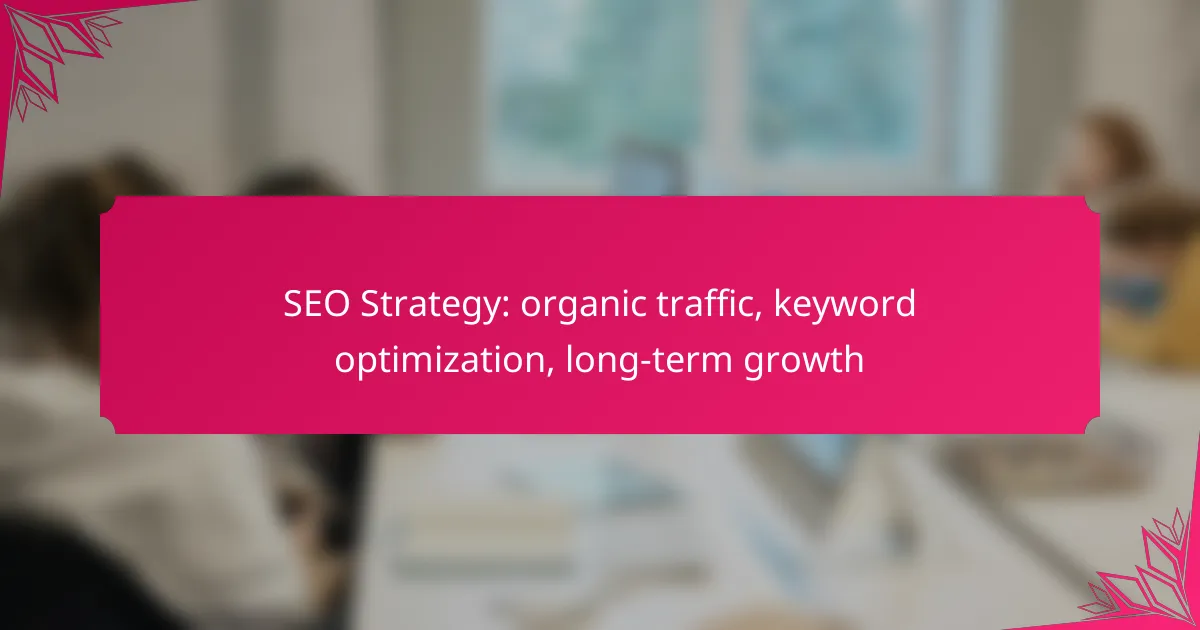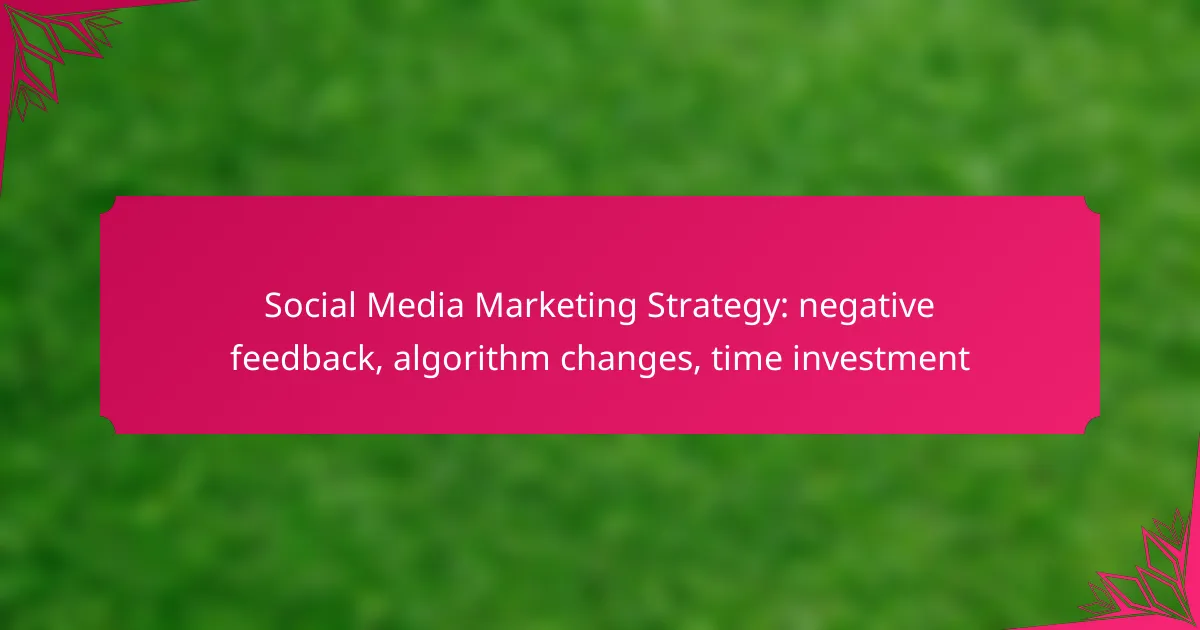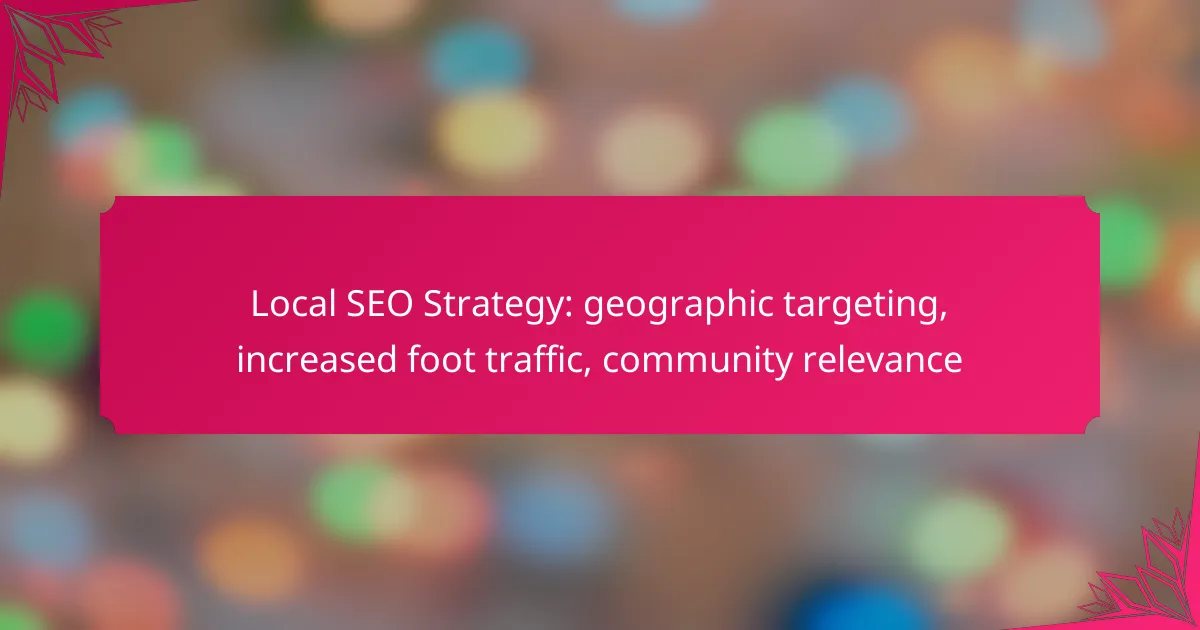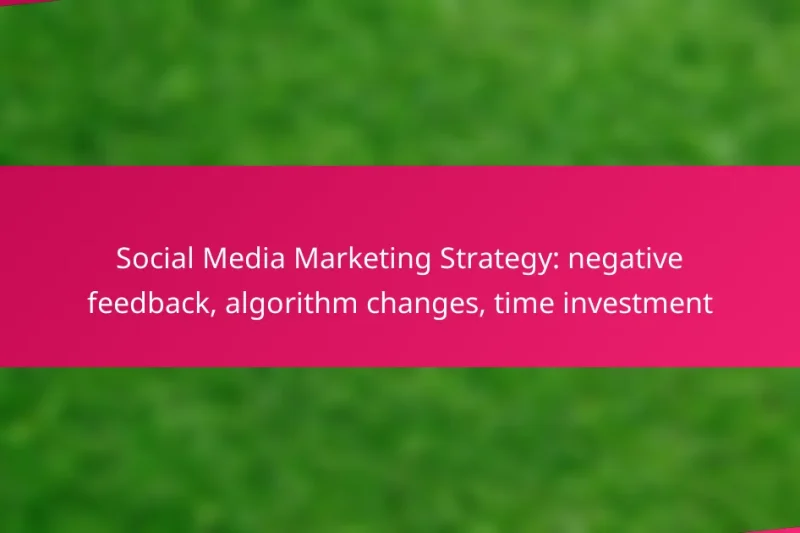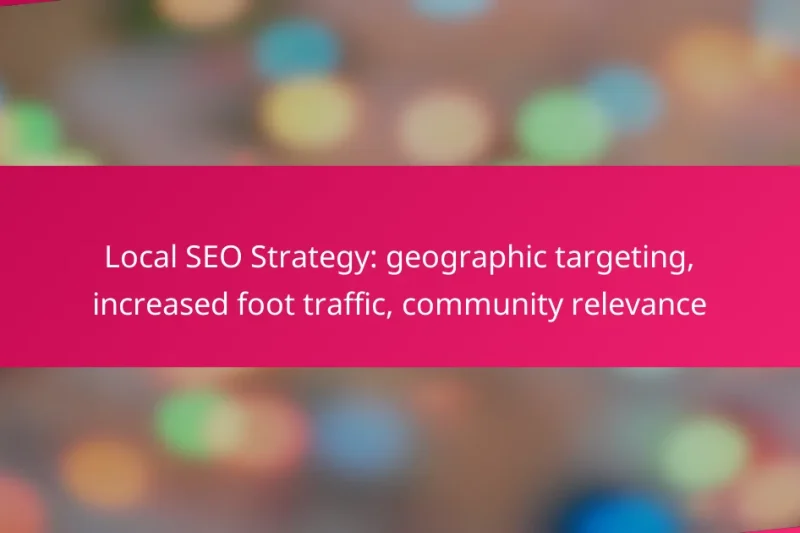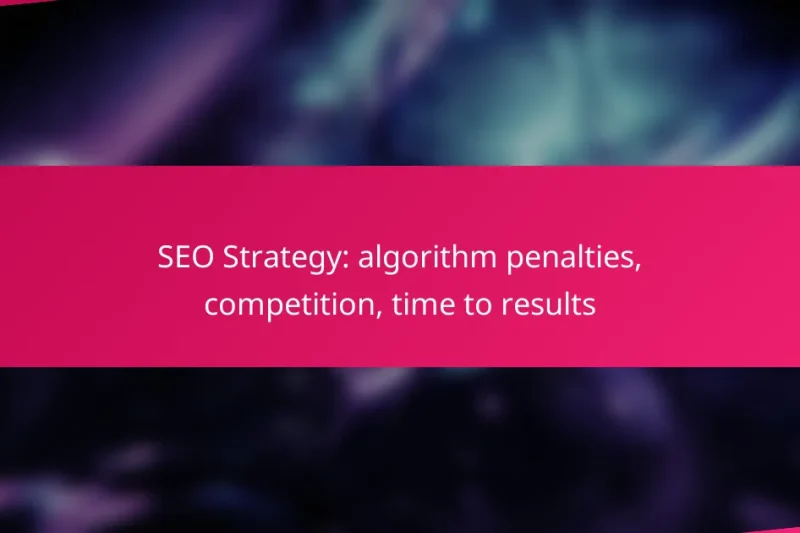Implementing a robust SEO strategy is essential for driving organic traffic and achieving long-term growth. By … SEO Strategy: organic traffic, keyword optimization, long-term growthRead more
Digital marketing encompasses a variety of strategies designed to enhance online presence and engage target audiences effectively. Key approaches include content marketing, search engine optimization (SEO), social media marketing, email marketing, and pay-per-click (PPC) advertising, each offering unique advantages. By leveraging these strategies, businesses can build brand awareness, foster customer loyalty, and drive conversions tailored to their specific goals.
Social Media Marketing Strategy: negative feedback, algorithm changes, time investment
In today’s dynamic landscape of social media marketing, effectively managing negative feedback is essential for maintaining … Social Media Marketing Strategy: negative feedback, algorithm changes, time investmentRead more
Local SEO Strategy: geographic targeting, increased foot traffic, community relevance
Implementing a robust local SEO strategy is essential for businesses aiming to increase foot traffic and … Local SEO Strategy: geographic targeting, increased foot traffic, community relevanceRead more
SEO Strategy: algorithm penalties, competition, time to results
Developing an effective SEO strategy requires a keen understanding of algorithm penalties, competition, and the time … SEO Strategy: algorithm penalties, competition, time to resultsRead more
Influencer Marketing Strategy: influencer selection, campaign guidelines, performance tracking
Influencer marketing can significantly enhance your brand’s reach and engagement when executed effectively. Selecting the right … Influencer Marketing Strategy: influencer selection, campaign guidelines, performance trackingRead more
Content Marketing Strategy: audience engagement, brand authority, SEO benefits
Content marketing is a powerful strategy that enhances audience engagement by delivering valuable and relevant content … Content Marketing Strategy: audience engagement, brand authority, SEO benefitsRead more
Affiliate Marketing Strategy: partner recruitment, commission structure, promotional materials
Implementing a successful affiliate marketing strategy requires a focus on partner recruitment, commission structures, and promotional … Affiliate Marketing Strategy: partner recruitment, commission structure, promotional materialsRead more
Email Marketing Strategy: spam filters, list fatigue, compliance issues
Email marketing is a powerful tool, but it comes with challenges such as navigating spam filters, … Email Marketing Strategy: spam filters, list fatigue, compliance issuesRead more
Content Marketing Strategy: content saturation, inconsistent messaging, resource demands
In today’s competitive landscape, businesses must navigate content saturation by implementing targeted strategies that prioritize relevance … Content Marketing Strategy: content saturation, inconsistent messaging, resource demandsRead more
PPC Advertising Strategy: budget overruns, click fraud, ad fatigue
PPC advertising can be a powerful tool for driving traffic and conversions, but it also presents … PPC Advertising Strategy: budget overruns, click fraud, ad fatigueRead more
What are the most effective digital marketing strategies?
The most effective digital marketing strategies include content marketing, search engine optimization (SEO), social media marketing, email marketing, and PPC advertising. Each strategy has unique strengths and can be tailored to meet specific business goals and target audiences.
Content marketing
Content marketing focuses on creating and distributing valuable content to attract and engage a target audience. This can include blog posts, videos, infographics, and podcasts. The goal is to build brand awareness and establish authority in your industry.
To implement effective content marketing, identify your audience's needs and preferences. Use analytics to track engagement and adjust your strategy accordingly. Consistency in publishing is key, aiming for a regular schedule that keeps your audience coming back for more.
Search engine optimization (SEO)
SEO involves optimizing your website and content to improve visibility in search engine results. This can be achieved through keyword research, on-page optimization, and building backlinks. Effective SEO increases organic traffic and enhances user experience.
Focus on both technical and content aspects of SEO. Ensure your website loads quickly and is mobile-friendly. Regularly update your content to keep it relevant and valuable, and consider using tools like Google Analytics to monitor performance and make data-driven adjustments.
Social media marketing
Social media marketing uses platforms like Facebook, Instagram, and Twitter to promote products or services and engage with customers. It allows businesses to reach a broad audience and foster community interaction. Effective campaigns often include a mix of organic posts and paid advertisements.
To succeed in social media marketing, create a content calendar that outlines your posting schedule and themes. Engage with your audience through comments and messages, and use analytics to measure the effectiveness of your campaigns. Tailor your approach to each platform's unique audience and features.
Email marketing
Email marketing involves sending targeted messages to a list of subscribers to promote products, share news, or provide value. It is a cost-effective way to communicate directly with customers and can yield high returns on investment when executed properly.
Build your email list through sign-up forms on your website and social media. Segment your audience to send personalized content that resonates with different groups. Monitor open and click-through rates to refine your approach and improve engagement over time.
PPC advertising
PPC (pay-per-click) advertising allows businesses to display ads on search engines and social media platforms, paying only when users click on their ads. This strategy can generate immediate traffic and leads, making it a popular choice for many marketers.
To optimize your PPC campaigns, conduct thorough keyword research to target relevant terms. Set clear budgets and bidding strategies, and regularly analyze performance metrics to adjust your campaigns for better results. A/B testing different ad copies can also help identify what resonates best with your audience.
How can businesses leverage content marketing?
Businesses can leverage content marketing by creating and distributing valuable content that attracts and engages their target audience. This strategy builds brand awareness, fosters customer loyalty, and drives conversions through informative and entertaining materials.
Creating valuable blog posts
Valuable blog posts should address the interests and pain points of your audience. Focus on providing actionable insights, tips, or solutions that resonate with readers. Aim for a consistent posting schedule to keep your audience engaged and returning for more.
Consider using SEO best practices to enhance visibility. Incorporate relevant keywords, optimize headings, and include internal and external links to improve search engine rankings. Aim for posts that are at least 800-1,200 words for comprehensive coverage of topics.
Developing engaging videos
Engaging videos can capture attention more effectively than text alone. Use storytelling techniques to convey your message and keep viewers interested. Aim for videos that are concise, ideally under three minutes, to maintain viewer engagement.
Utilize platforms like YouTube or social media for distribution. Ensure videos are optimized for mobile viewing, as a significant portion of users access content on their smartphones. Include clear calls to action to guide viewers on the next steps.
Utilizing infographics
Infographics are a powerful way to present complex information visually. They can simplify data and enhance understanding, making them shareable across social media platforms. Focus on clarity and aesthetics to ensure your infographic is both informative and visually appealing.
When creating infographics, use a mix of statistics, charts, and concise text. Aim for a balanced design that guides the viewer's eye through the information. Consider sharing your infographics on platforms like Pinterest or LinkedIn to reach a broader audience.
What is the role of SEO in digital marketing?
SEO, or Search Engine Optimization, is crucial in digital marketing as it enhances a website's visibility in search engine results. By optimizing content and site structure, businesses can attract more organic traffic, leading to increased brand awareness and potential sales.
Improving organic search visibility
Improving organic search visibility involves optimizing website content to rank higher in search engine results pages (SERPs). This includes using relevant keywords, creating high-quality content, and ensuring proper site structure. Effective SEO practices can elevate a website's position, making it more likely for users to click on it.
Consider focusing on long-tail keywords that are specific to your niche, as they often face less competition and can drive targeted traffic. Regularly updating content and monitoring keyword performance can also enhance visibility over time.
Enhancing website user experience
Enhancing user experience (UX) is a vital aspect of SEO that impacts how visitors interact with a website. A well-structured site with intuitive navigation, fast loading times, and mobile responsiveness encourages users to stay longer and engage more. Search engines reward sites that provide a positive UX with higher rankings.
To improve UX, ensure your website is easy to navigate, with clear calls to action. Tools like Google PageSpeed Insights can help identify areas for improvement, such as optimizing images or reducing server response times.
Increasing website traffic
Increasing website traffic through SEO involves attracting more visitors via organic search results. Effective keyword targeting, quality backlinks, and engaging content can significantly boost traffic levels. A well-executed SEO strategy can lead to a steady influx of visitors over time.
To maximize traffic, consider implementing a content marketing strategy that includes blog posts, infographics, and videos. Regularly analyzing traffic sources and user behavior can help refine your approach and identify new opportunities for growth.
How to choose the right social media platforms?
Choosing the right social media platforms involves understanding where your target audience spends their time and how they engage with content. Consider factors such as demographics, platform features, and your marketing goals to make an informed decision.
Identifying target audience demographics
Start by researching the demographics of your target audience, including age, gender, location, and interests. Different platforms attract different user bases; for example, Instagram tends to have a younger audience, while Facebook has a broader age range.
Utilize tools like Google Analytics or social media insights to gather data on your existing audience. This information will help you determine which platforms are most relevant for your marketing efforts.
Analyzing platform engagement rates
Engagement rates are crucial for assessing how effectively your content resonates with users on each platform. Look for metrics such as likes, shares, comments, and overall interaction rates to gauge performance.
Consider testing different types of content across platforms to see where you achieve the highest engagement. For instance, video content may perform better on TikTok and Instagram, while text-based posts might be more effective on Twitter and LinkedIn.
What are the benefits of email marketing?
Email marketing offers numerous advantages, including cost-effectiveness and direct communication with customers. It enables businesses to engage their audience, promote products, and drive conversions efficiently.
High ROI potential
Email marketing is known for its high return on investment (ROI). Businesses can expect an average ROI of around 40 USD for every 1 USD spent, making it one of the most effective marketing channels. This efficiency stems from low operational costs and the ability to reach a large audience quickly.
To maximize ROI, focus on segmenting your email lists to target specific customer groups. Tailored campaigns often yield better results than generic messages, leading to higher engagement and conversion rates.
Personalization capabilities
Personalization in email marketing allows businesses to customize messages based on customer behavior, preferences, and demographics. This strategy enhances user experience and increases the likelihood of engagement. For instance, addressing recipients by their first name can significantly improve open rates.
Utilize data analytics to track customer interactions and preferences. By sending personalized recommendations or special offers based on past purchases, brands can foster loyalty and encourage repeat business. However, avoid over-personalization, which may come off as intrusive.
What is PPC advertising and how does it work?
PPC advertising, or pay-per-click advertising, is a digital marketing strategy where advertisers pay a fee each time their ad is clicked. It primarily works through platforms like Google Ads, allowing businesses to bid on keywords relevant to their products or services to drive traffic to their websites.
Pay-per-click model explained
The pay-per-click model operates on an auction system where advertisers bid on keywords. When a user searches for a term that matches the keyword, the search engine displays ads based on the bid amount and the ad's quality score. Advertisers only pay when their ad is clicked, making it a cost-effective way to gain visibility.
Key factors influencing the success of PPC campaigns include keyword selection, ad relevance, and landing page quality. Advertisers should continuously monitor and optimize their campaigns to improve performance and return on investment.
Benefits of Google Ads
Google Ads offers several advantages for businesses looking to leverage PPC advertising. It provides access to a vast audience, as Google processes billions of searches daily. This platform allows precise targeting based on demographics, location, and user behavior, ensuring ads reach the right audience.
Additionally, Google Ads offers robust analytics tools that help advertisers track performance and adjust strategies accordingly. Advertisers can set budgets that suit their financial capabilities, making it accessible for both small businesses and large enterprises.
